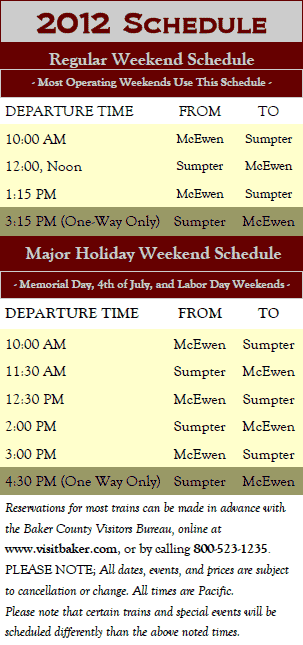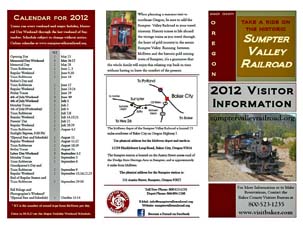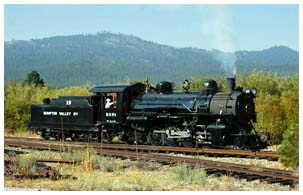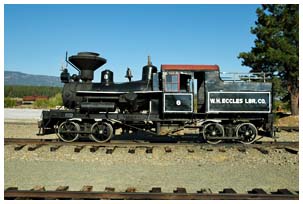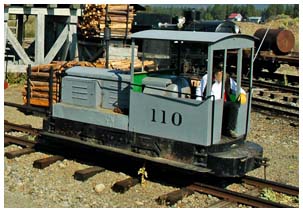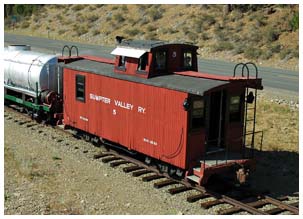 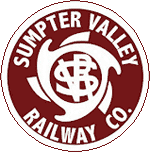 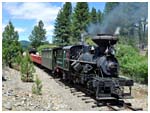 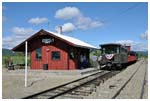 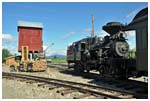 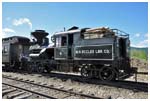 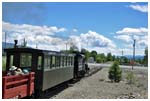 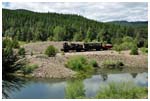 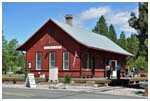 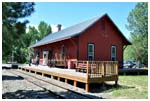 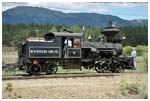 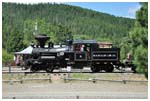 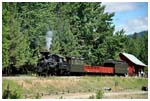 | Sumpter Valley Railway
The name Sumpter, in Oregon, was derived from historic Fort Sumter in Charleston harbour, South Carolina, where the American Civil War began in 1861. But that's a whole different story. The Oregon town of Sumpter lies in the wide Sumpter Valley of the Blue Mountains near the eastern border of the state. It might be called an ecological disaster area as the gold dredges which scoured the pristine valley created undulating piles of gravel along its length. Certainly such mining practices would not be tolerated today. The reconstructed three foot narrow gauge Sumpter Valley Railway carries tourists and railfans between McEwen and Sumpter, a distance of about 7 miles, utilizing the only operational three foot gauge wood-burning Heisler left in existence and restored Baldwin 2-8-2 Mikado steam locomotive number 19 built in 1920. During this 2012 visit Mike 19 was not operational due to tube replacements and various other repairs. My last visit to the Sumpter Valley Railway was in 2006. The operation appears to be the same as it was then. Trains depart from McEwen and travel up the valley northwest to Sumpter. Upon arrival the locomotive is decoupled then runs-around the train in preparation for the return journey. The entire round trip takes approximately one hour with a layover at Sumpter. The gold dredge at Sumpter is well worth exploring before the return to McEwen. Back in 2006 the railway had the intention of building a loop track around the Sumpter depot and dredge but this has not yet been accomplished. Even bigger plans were afoot back then as an extension from McEwen eastwards to the Union Creek Campground with a return loop was also in the works. Hopefully the railway has not given up on these goals which would greatly enhance the operation. As for equipment the Heisler and Mike remain the two main steam locomotives. At the time of this writing, work to return number 19, the Mike, to service is well underway towards completion and I would estimate it could be operational by next summer. A complete list of locomotives and rolling stock is available on the Sumpter Valley Railway web site. The Sumpter Valley Railway Company was incorporated in the state of Oregon, 18 Aug 1890 as a narrow gauge line with its rails set 36 inches apart. This was due to the mountainous terrain the railway had to cross. A narrow gauge permits tighter curves and a smaller footprint than standard gauge so is, theoretically, cheaper to construct. The railroad primarily hauled people, logs, and lumber. The grade followed the Powder River through Bowen Valley to Salisbury, 9 miles south of Baker. After passing through the Boulder Gorge the line was fairly straight down open meadows. Curry, a logging camp set in a wide flat meadow on the route to McEwen, now lies beneath Phillips reservoir. The track followed the river to McEwen arriving in 1891 where a depot was built. For four years McEwen was the end of the line. Joseph Barton was hired to locate a new right-of-way and directed the grading and track laying for the six miles from McEwen to Sumpter where it arrived in 1896. The population of Sumpter was 200 people at that time, but the railroad opened a floodgate of people. Sumpter's population mushroomed almost overnight to 1,500 souls. Less than a year later the unofficial population count rose to 9,000. By 1900 the track gangs were laying rail again, over Larch summit at an altitude of 5,094 feet, and down the west side of Huckleberry Mountain. By 1901, the tracks reached the town site now known as Whitney. Tracks were constructed from Whitney in all directions. Some spur lines went 14 miles into the woods and it was not long before a depot was built at Whitney. During the summer of 1903, track crews extended the rails across the Whitney Valley, over the North Fork of the Burnt River, and up the pass over the Greenhorn Mountains to Tipton Summit at 5,127 feet. In 1904 a station was built at Tipton and a wye constructed to turn the helper locomotives. From Tipton the SVR entered Grant County, traveling down the mountain to what later became White Pine. Soon the rails were reaching down the mountain side 8 miles from White Pine, arriving at the stage stop of Austin in 1905. Between 1905 and 1906 the gold mines in the area began to lose their yield and closed down. The SVR continued to haul logs and lumber after the gold was depleted. In 1909 the track crews began constructing the final segment of the railway 21 miles south of Austin. By 1910 tracks descended to the John Day Valley, crossed the John Day River, and were laid into Prairie City. The railway now extended 80.1 miles from Baker City. The final end to the railway began in 1933 with the Great Depression when the SVR abandoned its mainline from Bates to Prairie City. By 1937, passenger service along the line was discontinued. For the next 10 years a paying passenger could only ride in the caboose of the daily freight train. In 1939 the SVR bought the largest locomotives ever built for an American narrow gauge railroad. These were the 2-6-6-2 Mallets designed by Lucien Sprague for the Unitah Railway. From 1940 to 1947 these articulated Mallets pulled log loads and lumber from the sawmills to South Baker. The last freight train steamed into South Baker on 12 Jun 1947. Shortly thereafter the rails were pulled up and the lines completely dismantled. The land on which the tracks were laid was sold or abandoned. Sumpter Valley Railway published the following folder for the 2012 season.
30 Mar 1903 - Sumpter Smelter Blows in Soon
Sumpter Valley Railway Vancouver Island |


